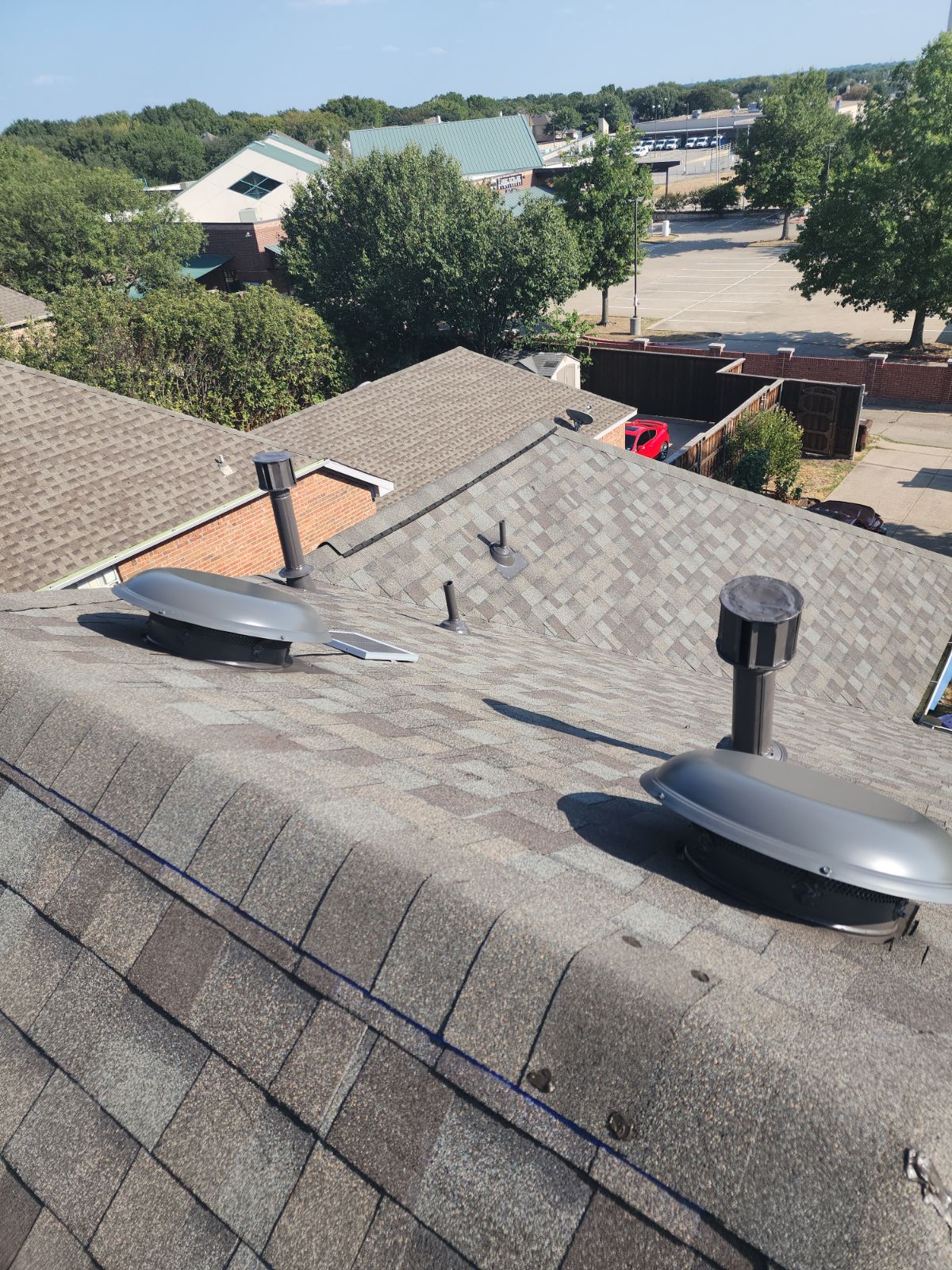
24 May WHAT IS PROPER ROOF AND ATTIC VENTILATION FOR TEXAS?
After receiving a lot of great correspondence regarding a controversial picture posted by HonestRoof.com, as well as seeing thousands of contractors and home builders in Dallas/Fort Worth leaving out a very important and much needed step when replacing a roof or building a home, we felt this would make a great topic for our next post.
WHAT IS THE PROPER ROOF AND ATTIC VENTILATION FOR TEXAS?
There seems to be a lot of opinions out there regarding attic and roof ventilation. None more heated then the topic of ridge-vents being used in combination with other attic ventilators.
THIRTY YEARS OF TRIAL AND ERROR:
During the hottest part of the day, your attic space needs desperate help circulating the hot air out of your attic “as quickly as possible”.
Proper attic/roof ventilation is imperative to prolonging the life of any asphalt shingle roof system. It will also work to save you money in energy costs at the same time.
So, which one should you use?
After a 30 year experiment of trail and error, using and monitoring every roof vent ever invented, HonestRoof.com found that by adding a “low out put solar fan” (or fans) used in the correct combination with “ridge-venting” to be the perfect and consistent solution to yielding the most out of your attic venting dollars.
Especially at those hard to vent areas. You may have noticed parts of your home that appear to be hotter then others during the hot summer months. Or maybe even an increased power bill or excessive maintenance on heating and cooling equipment.
Hard to reach attic spaces or inadequate attic ventilation is typically directly related to these issues.
But, there is a catch. Experienced and careful attention to location is the key to any venting combination working properly.
Installing the solar fans at the wrong locations or cutting ridges at areas that should not be cut open, could actually have an adverse affect on attic air circulation.
There are also many roof systems (depending on the layout of your roof) that do not qualify to have any form of “combination venting” used. It is either one or the other.
However, we cannot stress enough the importance of hands on knowledge and long term on the job experience regarding proper placement and installation of attic venting. The average contractor or home builder has no experience with combination venting and is most likely relying on broad statements made by most product literature or manufacture recommendations. Which in large part actually recommends against using multiple venting types on the same roof.
The problem with this general rule, is that every roof and every attic space is different. Therefore, the layout of each particular roof and attic space should dictate the correct venting procedures. Not a prewritten general rule or recommendation.
Unless someone has spent a minimum of 20 years or more on a roof and/or inside and attic space, in first person, leading from the front, he or she simply is not experienced enough and/or has not been in business long enough, to make educated recommendations regarding the correct ventilation methods.
After almost 70 years in business, we have finally perfected the art of extreme temperature venting.
THE SCIENCE:
After trying all forms of ventilation, (wind turbines, ridge venting, turtle vents, soffit vents, etc.) unlike high powered electrical fans, “Solar Fans” do not run for long periods of time, do not have powerful air draws and do not require electricity bills to operate.
Because solar fans do not have powerful draws, only drawing approximately 800 cfm (cubic feet of air per minute) and will only run during direct sunlight, they do not interfere with the draw of ridge-venting, the way a high output electrical fan would. Especially when installing ridge vents in separate portions of the attic.
These findings, took years of paying close attention to customer feed back and performing regular inspections of the roof systems and attic ventilators that we installed within a 30 year period to determine.
Spending our entire day, 6 days a week, for the last 30 years, either inside an attic or on a roof installing shingles, has afforded us this unique, hands on, learning opportunity that the average contractor or product manufacture simply has not had the opportunity to experience.
When you hire a contractor, hands on experience is what you should be paying for. Not classroom certifications.
The average contractor calling themselves a roofer or a company owner today has never actually installed a roof with their own back and two hands.
Simply reading online product literature and/or manufactures specifications may not result in what is actually best for your particular attic space.
The reason being, is that most manufacture and/or product recommendations regarding ventilation, is based on data collected from in-door or warehouse experiments and algorithm mathematics, based on the net area of an attic space.
This of course simply cannot be applied to all homes or all attic spaces, which is only giving contractors and home builders an excuse to cheap out when it comes to ventilation.
Because all homes and attic spaces are different and all regions of the U.S. are different, manufacture recommendations typically do result in what is actually best for your particular roof or attic space, long term.
The proof? Look at what home builders are doing today. They are following the current attic venting codes with every new home build. Yet, we receive thousands of calls per year with reports of overheating on both old and new homes alike.
If their venting methods are correct, why is your attic space still getting unbearably hot?
WE TRIED THEM ALL:
Like the average rookie contractor, we started out the same way. Believing what we were reading and trying to follow the ventilation manufacture recommendations on every job.
We tried wind turbines, ridge-vents, adding ridge vents with turbines, adding more and/or less intake vents around the soffits of the home, to then trying power electrical fans.
After watching closely for years, we noticed none of these really seemed to meet our standards for getting as much heat out of the attic space as quickly as possible without being a constant maintenance issue.
It was not until we finally stumbled upon adding “Solar Fans” in combination with “Ridge-Venting” (strategically placed in the correct locations and only cut open at the correct areas), that we noticed an immediate difference in attic heat build up during extreme temperatures.
Not only could we see an immediate difference, customer after customer were now calling us to thank us in amazement at how big of a difference their homes felt.
Their homebuilder couldn’t do it. Their previous roof installers couldn’t do it. We did it.
BOTTOM LINE:
Less intense attic heat during the hottest part of the day, equals longer shingle life. Better for us. Better for our customers. Better for all shingle manufactures.
OTHER POSITIVE FACTORS:
Aside from excessive heat decline, we also noticed a decline in attic moisture during the winter. You may have seen or heard the myth of people putting trash bags over wind turbines during the winter. This is an assumption that they are losing heat out of their attic which is causing their homes to become to cool or require excessive heating inside.
The real issue is not the heat you may be losing out of your attic. It is the type and level of attic insulation inside your attic, or what you are losing out of economy grade and/or drafty doors, windows and siding.
DOORS, WINDOW’S & WALL INSULATION
Proper attic/wall insulation and energy efficient doors and windows allows you to keep that precious heat and air “inside the home” without worrying about losing energy out of the attic space or resorting to desperate roof climbing measures.
According to local Dallas Fort Worth insulation and energy efficiency companies, nearly all heating/cooling issues can be directly contributed to inadequate doors, windows or attic and wall insulation. Solve those problems and all your heating/cooling issues are over.
LET IT BREATHE:
Your attic space needs to be able to breathe, year round. Even in the winter.
Most heavy equipment, such as AC units and furnaces, found inside the attic spaces of most homes in DFW, require fresh air to run efficiently and properly for long periods of time, without requiring excessive maintenance, repair or replacement.
Trash bagging your roof exhaust holes or fully encapsulating your attic space prevents the intake of fresh air, which causes maintenance issues and moisture problems, as well as safety concerns from possible dangerous fume build up inside the attic.
HARMFUL AND DEADLY FUME BUILD UP:
Another advantage to having some type of actual fanned ventilator on the roof was fume build up prevention. In the event that one of the gas lines inside your attic space is punctured or chewed through by critters, (reported as a fairly common event) you do not want these deadly fumes building up inside your clogged up attic space. The same is to be said about the carbon monoxide poisoning venting from a large number of homes in Dallas/Forth Worth at the hot water tank or furnace flu pipe locations.
Any dislodging of these exhaust pipes inside your attic (reported as a common occurrence) and it could result in someone’s death. Carbon monoxide has no smell, making it very difficult to detect without the proper warning systems in place.
WE HAVE THE PROOF:
Most parts of the country simply do not experience the type of intense and dry heat that we see in Texas, or for as long as we experience it. What works in Ohio, would not apply in Texas.
It is not uncommon to see triple digit temperatures all the way into October in Dallas/Fort Worth.
Therefore, further experimentation was needed to find the real ventilation solution for our customers during these extended hot summer months. So, Honestroof.com stepped up to the plate.
But, like anyone who goes against the system, we are typically met with confrontation or disagreement from inexperienced contractors or those still holding on to the old way of thinking.
EXPERIENCE IS EVERYTHING:
Expert tips at this level are the difference between trusting your roof replacement to an actual hands on shingle installer, versus middleman companies or contractors only interested in handling your insurance claim.
Middleman companies, general contractors and/or insurance claim contractors are basing all of their opinions and recommendations on profit or class room information they are reading online or at manufacture websites. This is the same information that you can read yourself.
Our recommendations, are based on 30 years of “hands on” experience, actually being bent over on someone’s roof or in hundred degree temperatures inside an attic attic space, learning what works and what does not, by leading from the front.
After 3 generations in business, with hundreds of 5 star customer reviews and not one legitimate complaint or warranty issue with any of our jobs in almost 70 years, the proof is in black and white for all to see.
DO NOT BE FOOLED:
Although it may seem as if there is a roofing company on every corner in Dallas/Fort Worth. The truth is that 99% of them are simply middlemen or commission sales people, hoping to take over your insurance claim and cash in on a huge payday.
Why throw away all your insurance money or allow a contractor to squeeze your insurance company for all they can get?
Why not get something for your money.
There are not many of us out here who are actual hands on roof installers with your best interest in mind. Or who actually possess the high level of experience and knowledge being advertised.
In a world of middlemen, who do you trust?



Sorry, the comment form is closed at this time.